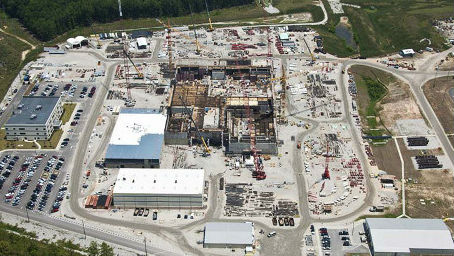In the current political era, it should come as no shock when elected officials say one thing and do another. Even so, it is hard not to be astonished at the recent behavior of South Carolina Senators Lindsey Graham and Tim Scott. Graham’s website says he “puts the interests of the taxpayer ahead of politics” while Scott’s proclaims that he is a “tireless advocate for smaller government, lower taxes, and restoring fiscal responsibility in Washington.”
For weeks, Sen. Graham has been blocking a vote on the confirmation of Ernest Moniz for secretary of energy. Is he doing this because of a question about the suitability of the highly qualified MIT professor and former energy undersecretary for the job? No. Sen. Graham has placed a hold on the nomination as blackmail to try to save the Department of Energy’s (DOE) ailing Mixed Oxide (MOX) Fuel Fabrication Facility project in his state, which over the last decade has wasted more than $3 billion of taxpayer money, and threatens to waste many billions more unless the DOE is able to shut off the spigot. And Sen. Scott is backing Graham all the way.
This is old-fashioned pork-barrel politics at its most fundamental: two senators trying to secure a gravy train of federal funding for their home state by keeping alive a project so flawed that even its sponsor and formerly biggest defender, DOE, appears poised to abandon it.
Ballooning Costs of the MOX Plant
DOE began building the MOX Fuel Fabrication Facility in 2007 at the Savannah River Site in South Carolina to convert a stockpile of weapons-grade plutonium that was no longer needed for military purposes into fuel (called MOX) for U.S. nuclear reactors. Because MOX fuel is more expensive than conventional nuclear fuel utilizing low-enriched uranium, the project was always projected to lose money for the government. But the price tag has ballooned since the DOE’s first optimistic estimate. The projected construction cost of the MOX fuel plant alone increased from about $1 billion in 2002 to $4.8 billion in 2007, while the estimated total project cost increased from about $4 billion to more than $15 billion.
Despite this, the DOE continued to press on. However, the most recent jump in the projected construction cost of the plant to $7.7 billion, at a time when the DOE’s overall budget was under unprecedented pressure, appears to have been the straw that broke the camel’s back. In its FY14 budget request, the DOE proposed a pause in construction of the plant in order to conduct a review of the program and consider alternatives. This is the action that so incensed Sens. Graham and Scott.
In fact, this program review is badly overdue. The MOX plant cost overrun is far from the only problem. The plant is being built “on spec,” since no utility has yet committed to use the fuel that it would produce, and there is no guarantee that a customer will be found to take the fuel off the DOE’s hands. Even though DOE will offer MOX fuel at a discount, the cost savings may not be enough to compensate utilities for the additional complications from storing and using MOX. For instance, since weapon-usable plutonium can be readily extracted from MOX fuel, MOX fuel requires a greater level of protection than low-enriched uranium fuel. If this security burden proves too troublesome for any utility to accept, the DOE could well be left with a $7.7 billion white elephant. In early 2011, I warned of the danger that this facility would become a “factory to nowhere.” Hundreds of millions of taxpayer dollars could have been saved if that warning had been heeded sooner.
Avoiding a White Elephant
Sen. Graham has said that he is willing to work with the DOE to try to bring down the cost of the plant. But cutting corners further would be a reckless enterprise at a facility intended to handle dozens of tons of a nuclear-weapons material that poses serious safety and security risks.
The DOE’s proposed review should consider alternatives for disposing of plutonium, such as immobilizing it in a glass or ceramic matrix, that would be safer and may prove cheaper. These options also could provide jobs at the Savannah River Site. True fiscal conservatives should welcome such a review.
Sen. Graham should release his hold on Professor Moniz’s nomination, and let the DOE assess the best way to move forward that will accomplish the mission of plutonium disposal, enhance security, and provide the best value to taxpayers.

